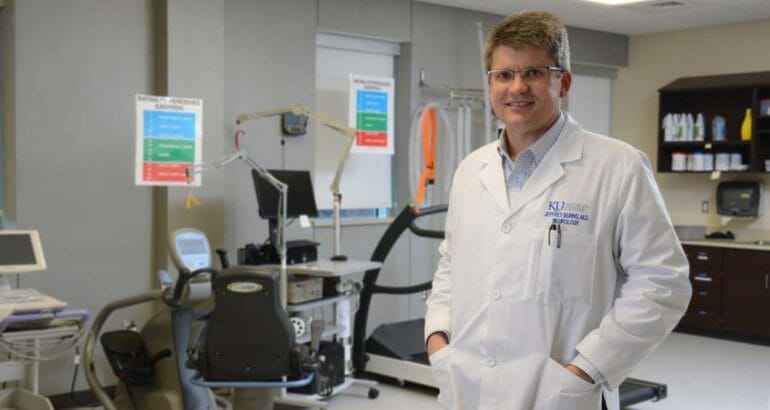Researchers are pursuing a cure and prevention.
By Jeffrey Burns, MD, Co-Director of the University of Kansas Alzheimer’s Disease Center & Professor of Neurology, University of Kansas School of Medicine
The first patient cured of Alzheimer’s disease will be in a clinical trial. As a researcher and as a physician, that gives me hope.
This year has brought some distressing news for Alzheimer’s disease patients and their families, as several pharmaceutical companies either stopped clinical trials or stopped research efforts in Alzheimer’s completely. And while that news is disappointing, it’s important to remember that there is still hope.
Here at the University of Kansas Alzheimer’s Disease Center (KU ADC), we are doubling down on our efforts to slow, stop, or prevent Alzheimer’s disease with a wide variety of clinical trials testing different approaches. As one of only 31 nationally designated Alzheimer’s Disease Research Centers, we are drawing on advances in drug development and molecular imaging to help lead an entirely new field of prevention science. Ongoing approaches are testing various prevention approaches — from drugs to diet and physical exercise — to reduce the long-term risk in healthy individuals who are at risk for developing the disease.
Advances in Technology Mean More Personalized Medicine
Right now, I believe it is important to think of Alzheimer’s as a treatable condition. Our standard treatment tools are limited, but we do know that doctors can make an accurate and early diagnosis, and physicians have proven medicines to help slow cognitive decline. However, we must strive to improve our limited diagnosis and treatment options. Alzheimer’s is often misdiagnosed, and our current treatments do not yet stop, reverse, or cure the disease.
We believe the day will come when doctors will recognize the disease years before the onset of its symptoms and in time to start new drugs that will stop, reverse, or cure the disease before it starts. We believe it is no longer a matter of if we will be able to do this, but it is a matter of when.
Why do we believe this? Rapid advances in PET scanning now allow us to see microscopic changes linked with Alzheimer’s disease — amyloid plaques and neurofibrillary tangles. Before this, we could only see these changes by examining the brain under the microscope after someone had died. This new technology works using FDA-approved tracers that are injected into the bloodstream, cross the blood brain barrier, and bind to their target, the amyloid plaque. PET scanners detect the tracer, allowing us to measure the amyloid. A similar technique to detect neurofibrillary tangles is now widely used in the research arena, including at the KU ADC.
This entirely new vision into the brain is likely to have broad implications in the future fight against Alzheimer’s. First, our ability to more accurately diagnose the disease should improve as amyloid PET scans are used (incorporated). Second, these imaging techniques may play a role in choosing specific therapies for individual patients as we enter an era of personalized medicine.
We are now testing approaches that target amyloid through the immune system, enzyme inhibitors that block the creation of amyloid and an approach that combines these two. We are also testing ways to stop the spread of tangles. And, we are most proud of our own drug development efforts testing whether increasing the metabolism of brain and body cells could have an impact on Alzheimer’s.
Prevention May Be the Key
These advances in drug development and molecular imaging have led to the emergence of an entirely new field of prevention science. We have known for some time that amyloid plaques are present up to 10 to 15 years before changes in memory are detected. A remarkable one out of three healthy older adults without signs of cognitive decline have amyloid buildup in the brain, suggesting they are at higher risk of developing the disease (though not all will).
 Since lifestyle changes may prevent or slow the disease, we also have created an Alzheimer’s prevention program called LEAP! (Lifestyle Empowerment for Alzheimer’s Prevention). LEAP! provides exercise and nutrition strategies empowering people to reduce their risk through healthy eating, exercise, cognitive engagement and better management of sleep and stress.
Since lifestyle changes may prevent or slow the disease, we also have created an Alzheimer’s prevention program called LEAP! (Lifestyle Empowerment for Alzheimer’s Prevention). LEAP! provides exercise and nutrition strategies empowering people to reduce their risk through healthy eating, exercise, cognitive engagement and better management of sleep and stress.
The single biggest obstacle in discovering a cure is finding volunteers. We have clinical trials open to healthy older adults as well as those who have cognitive decline. If you are interested in either trials or LEAP! Visit http://www.kualzheimer.org/ or call 913-588-0555.
The first person cured of Alzheimer’s will be in a clinical trial. Perhaps it will be someone from Kansas City.





